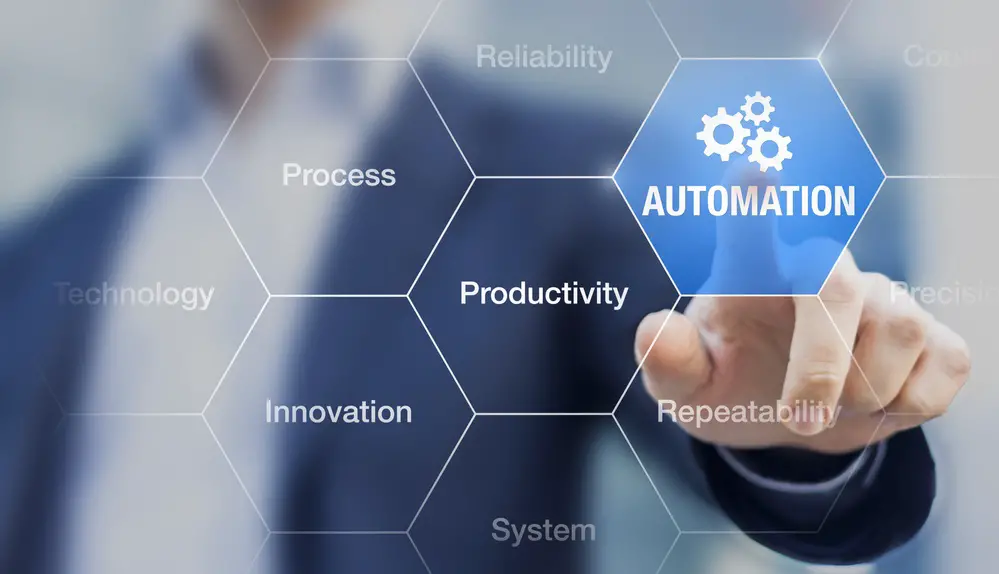As organizations expand, the demand for their products and services grows. While new processes are created in response to the increased demand, they are not always sufficient due to the tedious work tasks they often entail.
This leads to an overload of work actions that solely human effort can no longer complete. This is where Business Process Automation software (BPA) enters to provide better efficiency, minimize costs, satisfy constituents, and reduce time spent by individuals on complex work tasks.
Table of Contents
- Examples of Business Process Automation Software
- The Difference Between BPA & RPA
- Benefits of BPA
- Conclusion
Examples of Business Process Automation Software
Before we give examples of different BPAs, we actually need to define what they are.
A BPA uses technology to automate repeatable routine work tasks in a business. BPAs have specific goals and are designed explicitly to serve the needs of each company they are used in.
BPAs are often used to automate more complex work actions found in many different types of business processes related to sales, marketing, human resources, fundraising, etc.
BPAs employ several different types of software to automate a variety of individual tasks but also combine them. They are not just used to automate one type of task but instead reconfigure the entire work process from start to finish, allowing for better workflow in an organization.
BPAs take over operations that previously required manual work to increase efficiency and avoid human error, allowing an organization to contain costs and reorganize labor resources.

BPAs for Nonprofits
For example, BPAs are often implemented in fundraising through the use of IT software. When someone makes an online donation to an organization, a program records the donation and the donor’s personal information.
Another program processes the donation and receives the donated funds, while a third one automatically issues a confirmation notice and a receipt to the donor.
An example of this type of workflow automation would be Cflow’s workflow automation software, which can handle routine non-profit tasks like sending acknowledgments, follow-up calls, and reminders.
A BPA organizes all these separate specific tasks to work in tandem with the single goal of providing an easy and efficient experience to the donor.
BPAs for Payroll and HR
Other departments that heavily rely on BPAs include Treasury and Human Resources. Many Treasury or Payroll departments in different companies often take advantage of BPAs to handle employee payroll, invoicing, issuing receipts, and processing reimbursement requests.
An example of this type of BPA software would be Apogee HR, which provides HR collaboration tools along with notifications, reporting, and several other automation to improve payroll and administrative workflow.
Manually, these processes and tedious tasks might require a lot of time, but with BPAs, they can be completed much faster, which is very important considering that financial matters are often of greater importance and time-sensitive.
In Human Resources, BPAs are usually used to speed up the onboarding of new employees, including creating new contracts, reviewing the company’s regulations and safety protocols, and much more.
BPA for Customer Support
Furthermore, BPAs are often utilized for customer service-related processes.
Because they speed up actions that would usually take a more extended amount of time to be completed manually, BPAs tend to be preferred by companies with a lot of interactions between the business and its customers.
BPAs substitute processes that usually take a long time to increase customer satisfaction.
Think about when you wanted to contact a company for something you purchased, either a product or service.
If the company did not employ any BPAs, you probably had to send an email or call a phone number and leave a voicemail, and then wait a few days (not including the weekends) to hear back from a company representative.
For example, Front provides customer relationship software with automation and tracking tools for customer communications, team management, and data.
Even worse, you might have to call the customer support number, wait on hold for several minutes or even hours, and finally talk to someone about your issues.
These processes have been proven not to be the most efficient in terms of customer satisfaction as they require a lot of time, and patience from the customer, while also having various degrees of success. In contrast, BPAs are known to be able to offer higher turnaround times.
In this case, BPAs enable customers to get the support they need instantly without requiring an actual company representative to be available.
For example, a chatbot or a conversational AI can communicate with customers and offer them services and information that would help solve their issues.
These two examples are considered significant aspects of process automation that showcase how technology can be implemented to offer better services for improved business process management.
In another example, a BPA can also have one software to receive and collect email communication from customers sent to the company’s main email account.
Then, a separate project management application automatically inputs the emails and delegates them to different company employees, who would then deal with each inquiry personally.
The Difference Between BPA & RPA

A Robotic Process Automation (RPA) is essentially a form of a BPA. Unlike BPAs, RPAs are designed to do particular routine tasks, generally deemed simple but can be tedious if completed manually.
RPAs can substitute human efforts for generally repetitive but straightforward tasks but cannot organize together several different processes across an array of platforms like BPAs.
Robotic process automation software comes predesigned and is adaptable to the systems of the user.
On the contrary, BPAs are specifically designed to streamline the workflow of a specific business. While their main similarity is automation, their main difference is that RPAs are designed to do specific tasks on a single system, while BPAs organize and combine various processes across different systems.
For this reason, BPAs can often employ additional RPA software to perform different routine tasks, combining them with other software for a streamlined operation.
Benefits of BPA
BPAs are often credited for leading businesses into the initial stages of digital transformation. Indeed, many companies today turn to automation to simplify and make their operations more efficient, and there are many reasons for that.
BPAs Are Time-Saving
This kind of workflow automation can save businesses valuable time that can otherwise be used in better ways.
Long processing times, especially in customer support, can seriously affect the experiences a company is providing to its constituents. Consumer-focused companies highly value customer satisfaction, so long processing times can seriously damage their reputations.
Moreover, taking care of tedious and repetitive tasks can also prevent human error. Too often, to keep up with tight deadlines, employees rash to complete their assigned projects and make errors that might have severe implications for the company’s workflow. Employing a BPA saves time and avoids errors common with manual work.
BPAs Increase Employee Productivity
Employing a BPA solution to complete more tedious tasks enables a company to reorganize labor resources by delegating less monotonous tasks to their employees. This business automation can increase employee productivity.
Assigning monotonous work actions to your employees decreases their productivity and affects their overall performance, especially in a prolonged period. Therefore, the more satisfied your work team is, the better results they will produce.
BPAs Are Cost-Efficient
It is a fact that BPAs save time for businesses, but they also tend to reduce costs. A company might need a smaller work team when specific tasks are automatically completed or might require less time in overtime from their employees for jobs that might be time-sensitive.
Alongside the decrease in operational costs like labor costs, there is also a decrease in lost profit created due to inefficient processes. A business would spend less time and money fixing issues created from errors when its operations are automated.
Conclusion
BPAs are an essential aspect of today’s business operations. Digital transformation is indeed something that many companies and organizations explore due to the advantages that advanced technology can have to their processes’ efficiency and operational excellence.
Technological advancement has already affected and continues to impact the way people live their lives, simplifying several elements that used to seem impossible. Therefore, it is only the logical next step for technology to change how people do their work.
